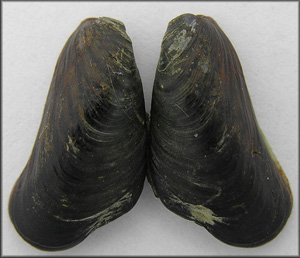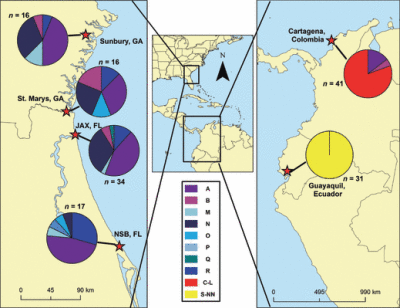Tracing the evolutionary history of a mussel invasion
 Evolutionary Bio,
Evolutionary Bio,  Invasive,
Invasive,  Marine
Marine Oh brother, where art thou...
I recently came across an interesting conservation-related study involving genetics - a topic I admittedly know little about. Nonetheless, I'm fascinated with how scientists are increasingly using genetcs to better understand exotic species invasion patterns. So, after some brief deliberation I decided to put my ignorance on display.
The study, appearing in the journal Diversity and Distributions, used genetic analysis to better understand the invasion history and genetic characteristics of the mussel Mytella charruana also knows as the Charrua mussel. The Charrua - a native to South America was first found in Jacksonville, Florida in 1986 covering a seawater intake pipe at the Northside Generator Power Plant (see beautiful image below). It has since been seen in other locations in Florida and Georgia. The researchers Nancy Gillis, Linda Walters, Flavio Fernandes and Eric Hoffman conducted genetic sequencing of invasive samples and native samples of the mussel to learn about the evolutionary history of the mussel in Florida.
 Mytella charruana at the Jacksonville Electric Authority Northside Generating Station. Image courtesy of www.jaxshells.org
Mytella charruana at the Jacksonville Electric Authority Northside Generating Station. Image courtesy of www.jaxshells.org
 Mytella charruana. Image courtesy of www.jaxshells.orgThe authors found that the mussels originated from Ecuador (see image below) and the that mussels from Colombia have not invaded Florida yet. The invasive mussels were most likely transported to the waters of Florida via shipping ballast water. The researchers looked at shipping channels to consider possible transport scenarios that resulted in the invasion.
Mytella charruana. Image courtesy of www.jaxshells.orgThe authors found that the mussels originated from Ecuador (see image below) and the that mussels from Colombia have not invaded Florida yet. The invasive mussels were most likely transported to the waters of Florida via shipping ballast water. The researchers looked at shipping channels to consider possible transport scenarios that resulted in the invasion.
 Distribution of Mytella charruana populations analysed in this study. Invasive populations of M. charruana have been found as far north as Sunbury, GA and as far south as New Smyrna Beach (NSB), FL. Different colours within pie graphs designate unique haplotypes and their frequencies within each population. Each colour represents the same haplotype among populations. Courtesy of Diversity and Distributions
Distribution of Mytella charruana populations analysed in this study. Invasive populations of M. charruana have been found as far north as Sunbury, GA and as far south as New Smyrna Beach (NSB), FL. Different colours within pie graphs designate unique haplotypes and their frequencies within each population. Each colour represents the same haplotype among populations. Courtesy of Diversity and Distributions
The study also found that contrary to the researchers expectations, the invasive mussels in some respects actually had greater genetic diversity than native Charrua. Invasive populations often have less diversity because of the founder effect - i.e. a few individuals arrive, and the population grows from that limited gene pool. The researchers conclude that this greater genetic diversity among the invasive mussels is the result of admixture - i.e. the establishment of a population via multiple invasions from different source populations. This dynamic for invasive species establishment is particularly interesting because it may entail a genetic competitive advantage versus native species.




Reader Comments